oil temperature KIA CADENZA 2018 Owners Manual
[x] Cancel search | Manufacturer: KIA, Model Year: 2018, Model line: CADENZA, Model: KIA CADENZA 2018Pages: 502, PDF Size: 9.77 MB
Page 308 of 502
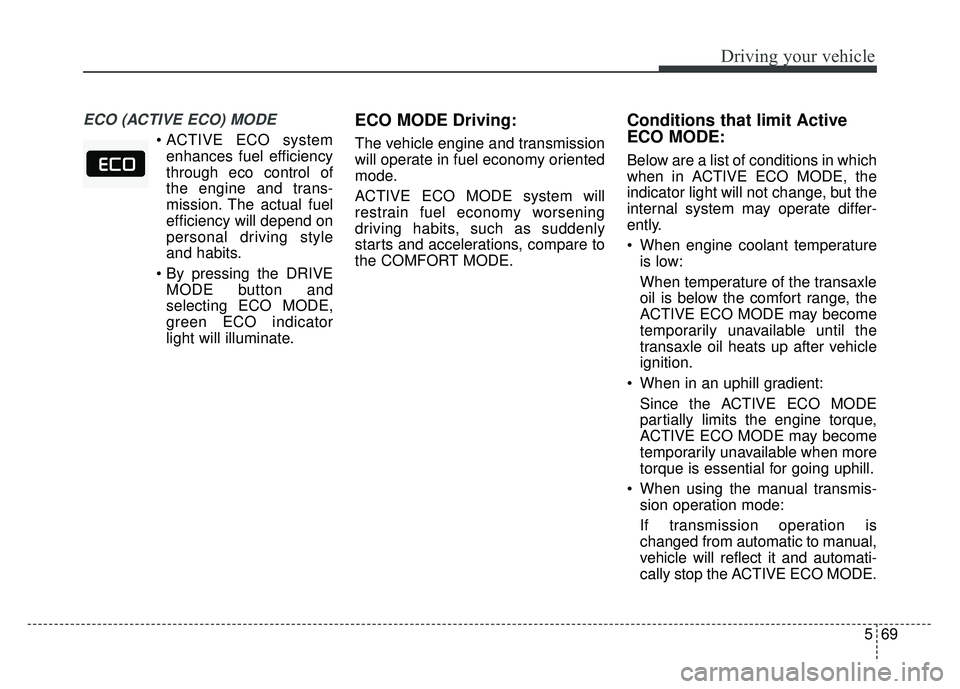
569
Driving your vehicle
ECO (ACTIVE ECO) MODE
enhances fuel efficiency
through eco control of
the engine and trans-
mission. The actual fuel
efficiency will depend on
personal driving style
and habits.
MODE button and
selecting ECO MODE,
green ECO indicator
light will illuminate.
ECO MODE Driving:
The vehicle engine and transmission
will operate in fuel economy oriented
mode.
ACTIVE ECO MODE system will
restrain fuel economy worsening
driving habits, such as suddenly
starts and accelerations, compare to
the COMFORT MODE.
Conditions that limit Active
ECO MODE:
Below are a list of conditions in which
when in ACTIVE ECO MODE, the
indicator light will not change, but the
internal system may operate differ-
ently.
When engine coolant temperature is low:
When temperature of the transaxle
oil is below the comfort range, the
ACTIVE ECO MODE may become
temporarily unavailable until the
transaxle oil heats up after vehicle
ignition.
When in an uphill gradient: Since the ACTIVE ECO MODE
partially limits the engine torque,
ACTIVE ECO MODE may become
temporarily unavailable when more
torque is essential for going uphill.
When using the manual transmis- sion operation mode:
If transmission operation is
changed from automatic to manual,
vehicle will reflect it and automati-
cally stop the ACTIVE ECO MODE.
Page 314 of 502
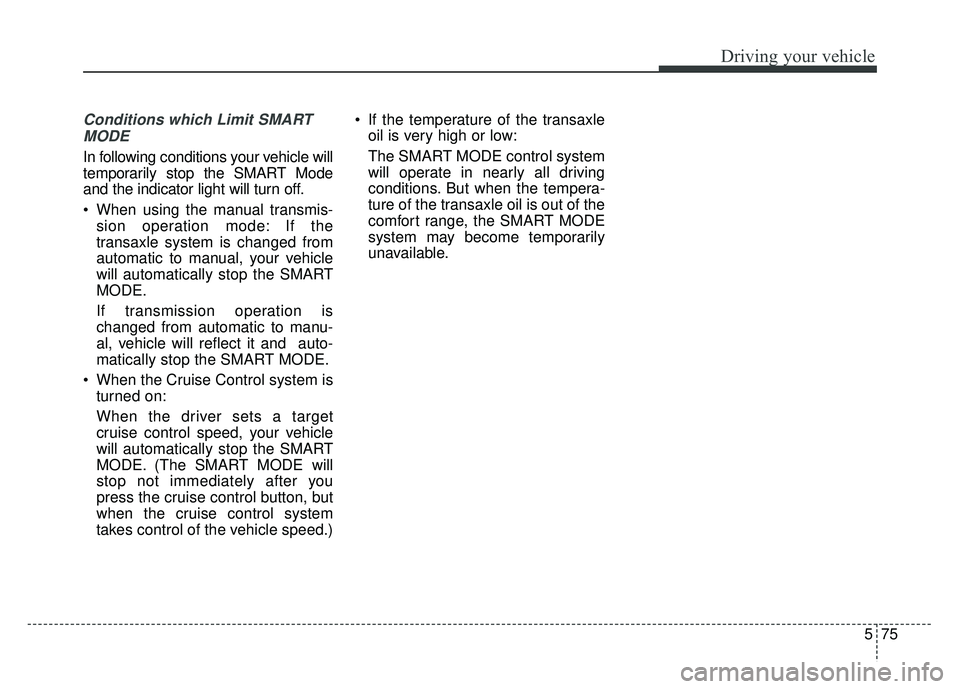
575
Driving your vehicle
Conditions which Limit SMARTMODE
In following conditions your vehicle will
temporarily stop the SMART Mode
and the indicator light will turn off.
When using the manual transmis- sion operation mode: If the
transaxle system is changed from
automatic to manual, your vehicle
will automatically stop the SMART
MODE.
If transmission operation is
changed from automatic to manu-
al, vehicle will reflect it and auto-
matically stop the SMART MODE.
When the Cruise Control system is turned on:
When the driver sets a target
cruise control speed, your vehicle
will automatically stop the SMART
MODE. (The SMART MODE will
stop not immediately after you
press the cruise control button, but
when the cruise control system
takes control of the vehicle speed.) If the temperature of the transaxle
oil is very high or low:
The SMART MODE control system
will operate in nearly all driving
conditions. But when the tempera-
ture of the transaxle oil is out of the
comfort range, the SMART MODE
system may become temporarily
unavailable.
Page 339 of 502
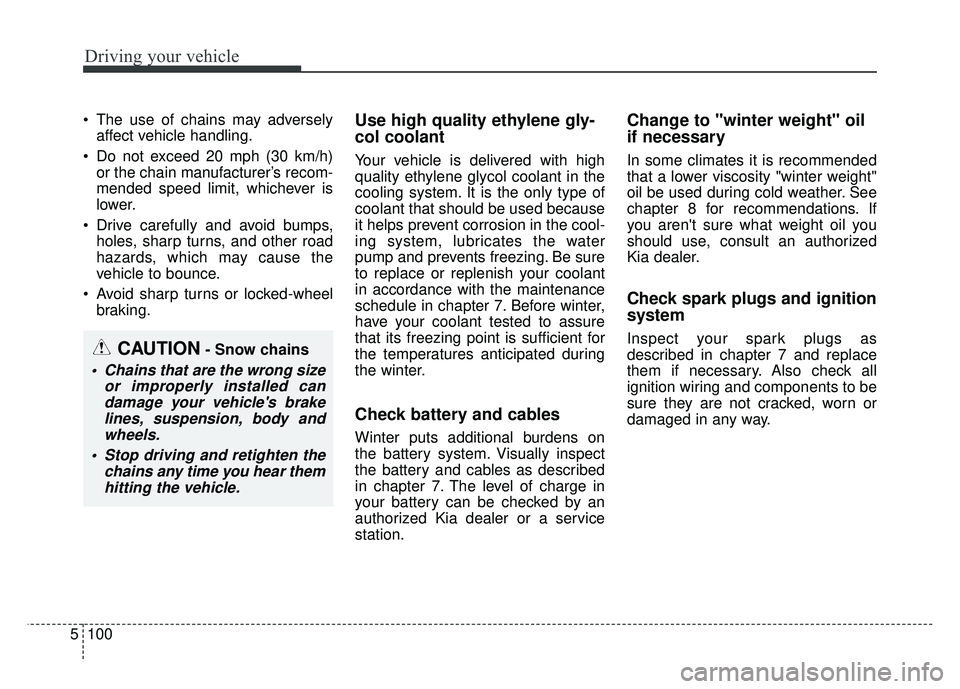
Driving your vehicle
100
5
The use of chains may adversely
affect vehicle handling.
Do not exceed 20 mph (30 km/h) or the chain manufacturer’s recom-
mended speed limit, whichever is
lower.
Drive carefully and avoid bumps, holes, sharp turns, and other road
hazards, which may cause the
vehicle to bounce.
Avoid sharp turns or locked-wheel braking.Use high quality ethylene gly-
col coolant
Your vehicle is delivered with high
quality ethylene glycol coolant in the
cooling system. It is the only type of
coolant that should be used because
it helps prevent corrosion in the cool-
ing system, lubricates the water
pump and prevents freezing. Be sure
to replace or replenish your coolant
in accordance with the maintenance
schedule in chapter 7. Before winter,
have your coolant tested to assure
that its freezing point is sufficient for
the temperatures anticipated during
the winter.
Check battery and cables
Winter puts additional burdens on
the battery system. Visually inspect
the battery and cables as described
in chapter 7. The level of charge in
your battery can be checked by an
authorized Kia dealer or a service
station.
Change to "winter weight" oil
if necessary
In some climates it is recommended
that a lower viscosity "winter weight"
oil be used during cold weather. See
chapter 8 for recommendations. If
you aren't sure what weight oil you
should use, consult an authorized
Kia dealer.
Check spark plugs and ignition
system
Inspect your spark plugs as
described in chapter 7 and replace
them if necessary. Also check all
ignition wiring and components to be
sure they are not cracked, worn or
damaged in any way.CAUTION- Snow chains
Chains that are the wrong size or improperly installed candamage your vehicle's brakelines, suspension, body andwheels.
Stop driving and retighten the chains any time you hear themhitting the vehicle.
Page 392 of 502

719
Maintenance
Maintenance Under Severe Usage Conditions
Severe Driving Conditions
A - Repeatedly driving short distance of less than 5 miles (8 km) in normaltemperature or less than 10 miles (16 km) in freezing temperature
B - Extensive engine idling or low speed driving for long distances
C - Driving on rough, dusty, muddy, unpaved, graveled or salt- spread roads
D - Driving in areas using salt or other corrosive materials or in very cold weather
E - Driving in heavy dust condition F - Driving in heavy traffic area
G - Driving on uphill, downhill, or mountain road
H - Towing a Trailer, or using a camper, or roof rack
I - Driving as a patrol car, taxi, other commercial use or vehicle towing
J - Driving over 106 mph (170 km/h)
K - Frequently driving in stop-and-go conditions
The following items must be serviced more frequently on cars normally used under severe driving conditions.
Refer to the chart below for the appropriate maintenance intervals.
R : Replace I : Inspect and, after inspection, clean, adjust, repair or replace if neces\
sary
MAINTENANCE ITEMMAINTENANCE
OPERATIONMAINTENANCE INTERVALSDRIVING CONDITION
Engine oil and filterREvery 3,750 miles (6,000 km) or 6 monthsA, B, C, D, E, F, G,
H, I, J, K
Air cleaner filterRMore frequentlyC, E
Spark plugsRMore frequentlyB, H
Automatic transmission fluidREvery 60,000 miles (96,000 km)A, C, E, F, G, I
Front brake disc/pads, calipersIMore frequentlyC, D, G, H
Rear brake disc/padsIMore frequentlyC, D, G, F
Parking brakeIMore frequentlyC, D, G, H
Steering gear box, linkage & boots/lower arm ball joint,
upper arm ball jointIMore frequentlyC, D, E, F, G, H, I
Drive shafts and bootsIMore frequentlyC, D, E, F, G, H, I, J
Climate control air filter (for evaporator and blower unit)RMore frequentlyC, E
Page 415 of 502
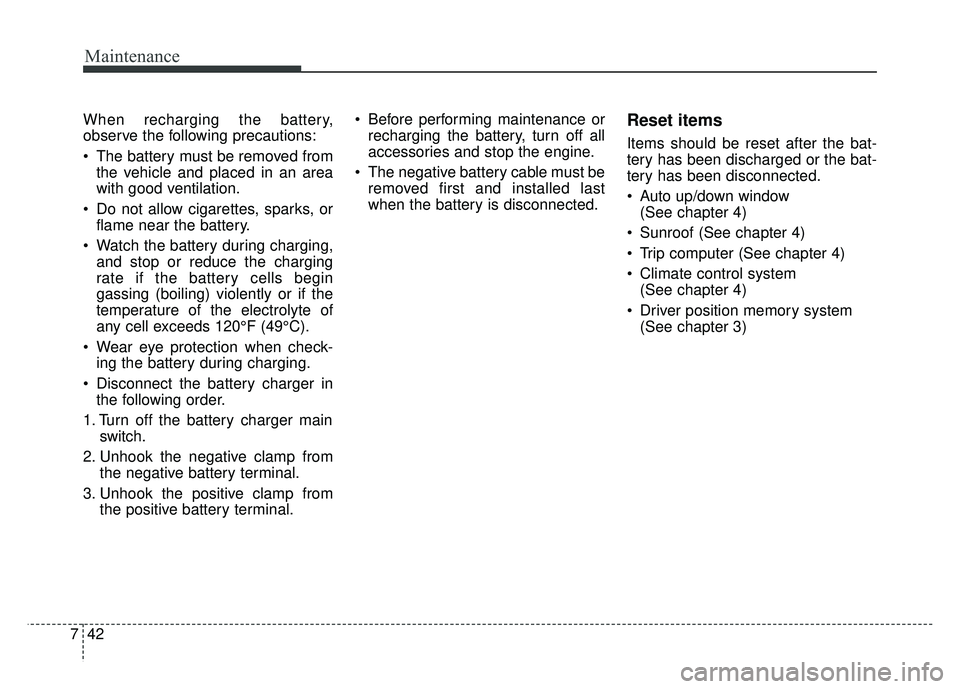
Maintenance
42
7
When recharging the battery,
observe the following precautions:
The battery must be removed from
the vehicle and placed in an area
with good ventilation.
Do not allow cigarettes, sparks, or flame near the battery.
Watch the battery during charging, and stop or reduce the charging
rate if the battery cells begin
gassing (boiling) violently or if the
temperature of the electrolyte of
any cell exceeds 120°F (49°C).
Wear eye protection when check- ing the battery during charging.
Disconnect the battery charger in the following order.
1. Turn off the battery charger main switch.
2. Unhook the negative clamp from the negative battery terminal.
3. Unhook the positive clamp from the positive battery terminal. Before performing maintenance or
recharging the battery, turn off all
accessories and stop the engine.
The negative battery cable must be removed first and installed last
when the battery is disconnected.Reset items
Items should be reset after the bat-
tery has been discharged or the bat-
tery has been disconnected.
Auto up/down window (See chapter 4)
Sunroof (See chapter 4)
Trip computer (See chapter 4)
Climate control system (See chapter 4)
Driver position memory system (See chapter 3)
Page 425 of 502
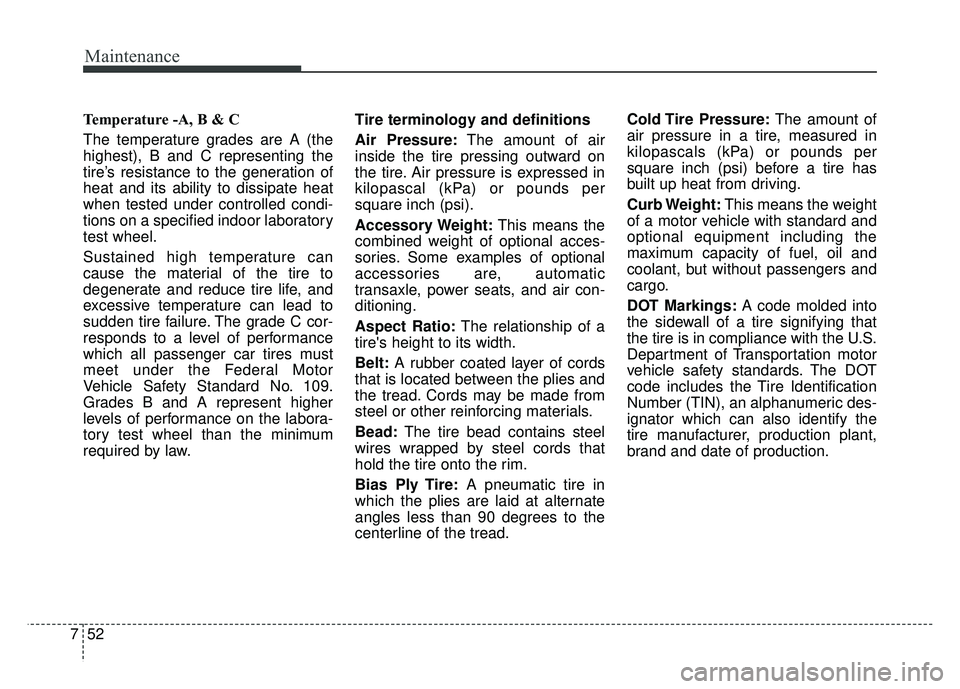
Maintenance
52
7
Temperature -A, B & C
The temperature grades are A (the
highest), B and C representing the
tire’s resistance to the generation of
heat and its ability to dissipate heat
when tested under controlled condi-
tions on a specified indoor laboratory
test wheel.
Sustained high temperature can
cause the material of the tire to
degenerate and reduce tire life, and
excessive temperature can lead to
sudden tire failure. The grade C cor-
responds to a level of performance
which all passenger car tires must
meet under the Federal Motor
Vehicle Safety Standard No. 109.
Grades B and A represent higher
levels of performance on the labora-
tory test wheel than the minimum
required by law. Tire terminology and definitions
Air Pressure:
The amount of air
inside the tire pressing outward on
the tire. Air pressure is expressed in
kilopascal (kPa) or pounds per
square inch (psi).
Accessory Weight: This means the
combined weight of optional acces-
sories. Some examples of optional
accessories are, automatic
transaxle, power seats, and air con-
ditioning.
Aspect Ratio: The relationship of a
tire's height to its width.
Belt: A rubber coated layer of cords
that is located between the plies and
the tread. Cords may be made from
steel or other reinforcing materials.
Bead: The tire bead contains steel
wires wrapped by steel cords that
hold the tire onto the rim.
Bias Ply Tire: A pneumatic tire in
which the plies are laid at alternate
angles less than 90 degrees to the
centerline of the tread. Cold Tire Pressure:
The amount of
air pressure in a tire, measured in
kilopascals (kPa) or pounds per
square inch (psi) before a tire has
built up heat from driving.
Curb Weight: This means the weight
of a motor vehicle with standard and
optional equipment including the
maximum capacity of fuel, oil and
coolant, but without passengers and
cargo.
DOT Markings: A code molded into
the sidewall of a tire signifying that
the tire is in compliance with the U.S.
Department of Transportation motor
vehicle safety standards. The DOT
code includes the Tire Identification
Number (TIN), an alphanumeric des-
ignator which can also identify the
tire manufacturer, production plant,
brand and date of production.
Page 480 of 502
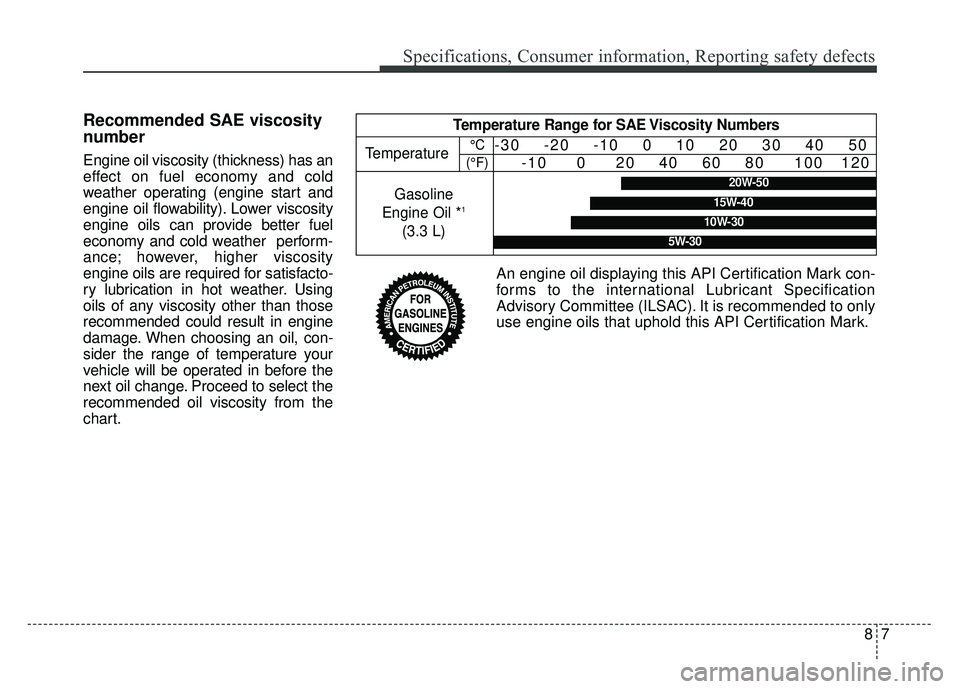
87
Specifications, Consumer information, Reporting safety defects
Recommended SAE viscosity
number
Engine oil viscosity (thickness) has an
effect on fuel economy and cold
weather operating (engine start and
engine oil flowability). Lower viscosity
engine oils can provide better fuel
economy and cold weather perform-
ance; however, higher viscosity
engine oils are required for satisfacto-
ry lubrication in hot weather. Using
oils of any viscosity other than those
recommended could result in engine
damage. When choosing an oil, con-
sider the range of temperature your
vehicle will be operated in before the
next oil change. Proceed to select the
recommended oil viscosity from the
chart.
Temperature Range for SAE Viscosity Numbers
TemperatureGasoline
Engine Oil *
1
(3.3 L)
°C
(°F)-30 -20 -10 0 10 20 30 40 50 -10 0 20 40 60 80 100 120
20W-50
10W-30
15W-40
5W-30
An engine oil displaying this API Certification Mark con-
forms to the international Lubricant Specification
Advisory Committee (ILSAC). It is recommended to only
use engine oils that uphold this API Certification Mark.
Page 492 of 502
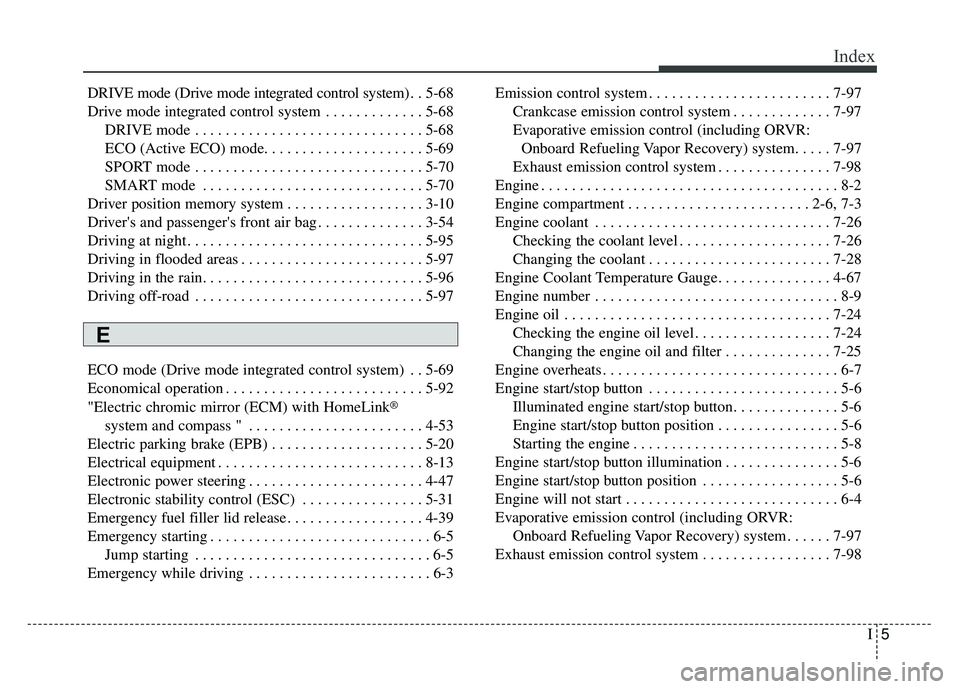
I5
Index
DRIVE mode (Drive mode integrated control system) . . 5-68
Drive mode integrated control system . . . . . . . . . . . . . 5-68 DRIVE mode . . . . . . . . . . . . . . . . . . . . . . . . . . . . . . 5-68
ECO (Active ECO) mode. . . . . . . . . . . . . . . . . . . . . 5-69
SPORT mode . . . . . . . . . . . . . . . . . . . . . . . . . . . . . . 5-70
SMART mode . . . . . . . . . . . . . . . . . . . . . . . . . . . . . 5-70
Driver position memory system . . . . . . . . . . . . . . . . . . 3-10
Driver's and passenger's front air bag . . . . . . . . . . . . . . 3-54
Driving at night . . . . . . . . . . . . . . . . . . . . . . . . . . . . . . . 5-95
Driving in flooded areas . . . . . . . . . . . . . . . . . . . . . . . . 5-97
Driving in the rain. . . . . . . . . . . . . . . . . . . . . . . . . . . . . 5-96
Driving off-road . . . . . . . . . . . . . . . . . . . . . . . . . . . . . . 5-97
ECO mode (Drive mode integrated control system) . . 5-69
Economical operation . . . . . . . . . . . . . . . . . . . . . . . . . . 5-92
"Electric chromic mirror (ECM) with HomeLink
®
system and compass " . . . . . . . . . . . . . . . . . . . . . . . 4-53
Electric parking brake (EPB) . . . . . . . . . . . . . . . . . . . . 5-20
Electrical equipment . . . . . . . . . . . . . . . . . . . . . . . . . . . 8-13
Electronic power steering . . . . . . . . . . . . . . . . . . . . . . . 4-47
Electronic stability control (ESC) . . . . . . . . . . . . . . . . 5-31
Emergency fuel filler lid release. . . . . . . . . . . . . . . . . . 4-39
Emergency starting . . . . . . . . . . . . . . . . . . . . . . . . . . . . . 6-5 Jump starting . . . . . . . . . . . . . . . . . . . . . . . . . . . . . . . 6-5
Emergency while driving . . . . . . . . . . . . . . . . . . . . . . . . 6-3 Emission control system . . . . . . . . . . . . . . . . . . . . . . . . 7-97
Crankcase emission control system . . . . . . . . . . . . . 7-97
Evaporative emission control (including ORVR:Onboard Refueling Vapor Recovery) system. . . . . 7-97
Exhaust emission control system . . . . . . . . . . . . . . . 7-98
Engine . . . . . . . . . . . . . . . . . . . . . . . . . . . . . . . . . . . . \
. . . 8-2
Engine compartment . . . . . . . . . . . . . . . . . . . . . . . . 2-6, 7-3
Engine coolant . . . . . . . . . . . . . . . . . . . . . . . . . . . . . . . 7-26 Checking the coolant level . . . . . . . . . . . . . . . . . . . . 7-26
Changing the coolant . . . . . . . . . . . . . . . . . . . . . . . . 7-28
Engine Coolant Temperature Gauge. . . . . . . . . . . . . . . 4-67
Engine number . . . . . . . . . . . . . . . . . . . . . . . . . . . . . . . . 8-9
Engine oil . . . . . . . . . . . . . . . . . . . . . . . . . . . . . . . . . . . 7-\
24 Checking the engine oil level . . . . . . . . . . . . . . . . . . 7-24
Changing the engine oil and filter . . . . . . . . . . . . . . 7-25
Engine overheats . . . . . . . . . . . . . . . . . . . . . . . . . . . . . . . 6-7
Engine start/stop button . . . . . . . . . . . . . . . . . . . . . . . . . 5-6 Illuminated engine start/stop button. . . . . . . . . . . . . . 5-6
Engine start/stop button position . . . . . . . . . . . . . . . . 5-6
Starting the engine . . . . . . . . . . . . . . . . . . . . . . . . . . . 5-8
Engine start/stop button illumination . . . . . . . . . . . . . . . 5-6
Engine start/stop button position . . . . . . . . . . . . . . . . . . 5-6
Engine will not start . . . . . . . . . . . . . . . . . . . . . . . . . . . . 6-4
Evaporative emission control (including ORVR: Onboard Refueling Vapor Recovery) system . . . . . . 7-97
Exhaust emission control system . . . . . . . . . . . . . . . . . 7-98
E
Page 497 of 502
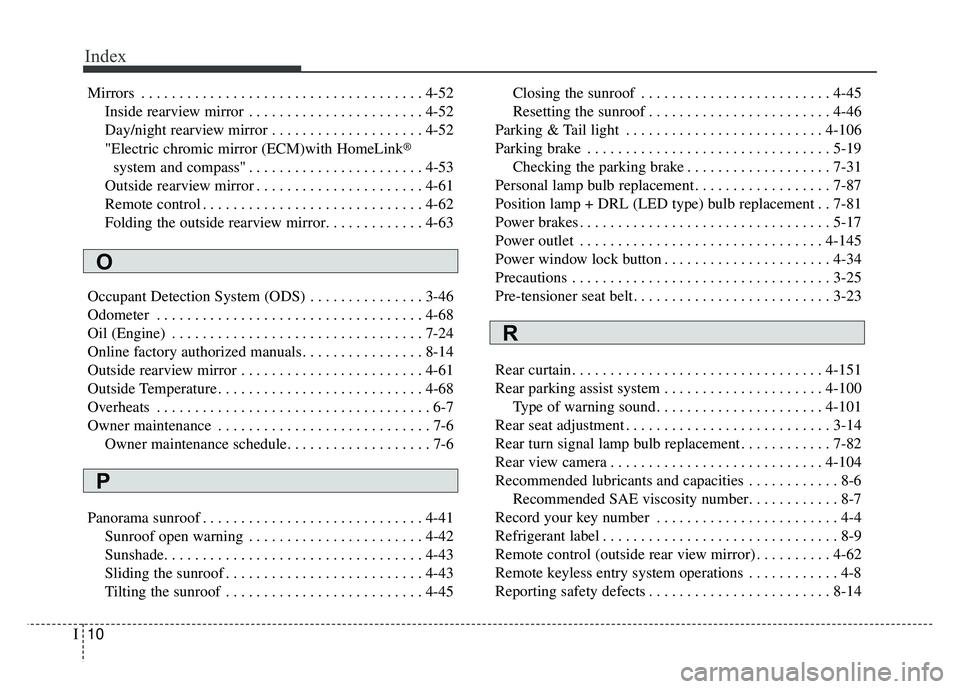
Index
10I
Mirrors . . . . . . . . . . . . . . . . . . . . . . . . . . . . . . . . . . . . \
. 4-52Inside rearview mirror . . . . . . . . . . . . . . . . . . . . . . . 4-52
Day/night rearview mirror . . . . . . . . . . . . . . . . . . . . 4-52
"Electric chromic mirror (ECM)with HomeLink
®
system and compass" . . . . . . . . . . . . . . . . . . . . . . . 4-53
Outside rearview mirror . . . . . . . . . . . . . . . . . . . . . . 4-61
Remote control . . . . . . . . . . . . . . . . . . . . . . . . . . . . . 4-62
Folding the outside rearview mirror. . . . . . . . . . . . . 4-63
Occupant Detection System (ODS) . . . . . . . . . . . . . . . 3-46
Odometer . . . . . . . . . . . . . . . . . . . . . . . . . . . . . . . . . . . 4-\
68
Oil (Engine) . . . . . . . . . . . . . . . . . . . . . . . . . . . . . . . . . 7-24
Online factory authorized manuals . . . . . . . . . . . . . . . . 8-14
Outside rearview mirror . . . . . . . . . . . . . . . . . . . . . . . . 4-61
Outside Temperature . . . . . . . . . . . . . . . . . . . . . . . . . . . 4-68
Overheats . . . . . . . . . . . . . . . . . . . . . . . . . . . . . . . . . . . . \
6-7
Owner maintenance . . . . . . . . . . . . . . . . . . . . . . . . . . . . 7-6 Owner maintenance schedule. . . . . . . . . . . . . . . . . . . 7-6
Panorama sunroof . . . . . . . . . . . . . . . . . . . . . . . . . . . . . 4-41 Sunroof open warning . . . . . . . . . . . . . . . . . . . . . . . 4-42
Sunshade. . . . . . . . . . . . . . . . . . . . . . . . . . . . . . . . . . 4-43\
Sliding the sunroof . . . . . . . . . . . . . . . . . . . . . . . . . . 4-43
Tilting the sunroof . . . . . . . . . . . . . . . . . . . . . . . . . . 4-45 Closing the sunroof . . . . . . . . . . . . . . . . . . . . . . . . . 4-45
Resetting the sunroof . . . . . . . . . . . . . . . . . . . . . . . . 4-46
Parking & Tail light . . . . . . . . . . . . . . . . . . . . . . . . . . 4-106
Parking brake . . . . . . . . . . . . . . . . . . . . . . . . . . . . . . . . 5-19 Checking the parking brake . . . . . . . . . . . . . . . . . . . 7-31
Personal lamp bulb replacement . . . . . . . . . . . . . . . . . . 7-87
Position lamp + DRL (LED type) bulb replacement . . 7-81
Power brakes . . . . . . . . . . . . . . . . . . . . . . . . . . . . . . . . . 5-17
Power outlet . . . . . . . . . . . . . . . . . . . . . . . . . . . . . . . . 4-145
Power window lock button . . . . . . . . . . . . . . . . . . . . . . 4-34
Precautions . . . . . . . . . . . . . . . . . . . . . . . . . . . . . . . . . . 3-25\
Pre-tensioner seat belt. . . . . . . . . . . . . . . . . . . . . . . . . . 3-23
Rear curtain. . . . . . . . . . . . . . . . . . . . . . . . . . . . . . . . . 4-151
Rear parking assist system . . . . . . . . . . . . . . . . . . . . . 4-100 Type of warning sound . . . . . . . . . . . . . . . . . . . . . . 4-101
Rear seat adjustment . . . . . . . . . . . . . . . . . . . . . . . . . . . 3-14
Rear turn signal lamp bulb replacement . . . . . . . . . . . . 7-82
Rear view camera . . . . . . . . . . . . . . . . . . . . . . . . . . . . 4-104
Recommended lubricants and capacities . . . . . . . . . . . . 8-6 Recommended SAE viscosity number. . . . . . . . . . . . 8-7
Record your key number . . . . . . . . . . . . . . . . . . . . . . . . 4-4
Refrigerant label . . . . . . . . . . . . . . . . . . . . . . . . . . . . . . . 8-9
Remote control (outside rear view mirror) . . . . . . . . . . 4-62
Remote keyless entry system operations . . . . . . . . . . . . 4-8
Reporting safety defects . . . . . . . . . . . . . . . . . . . . . . . . 8-14
O
P
R